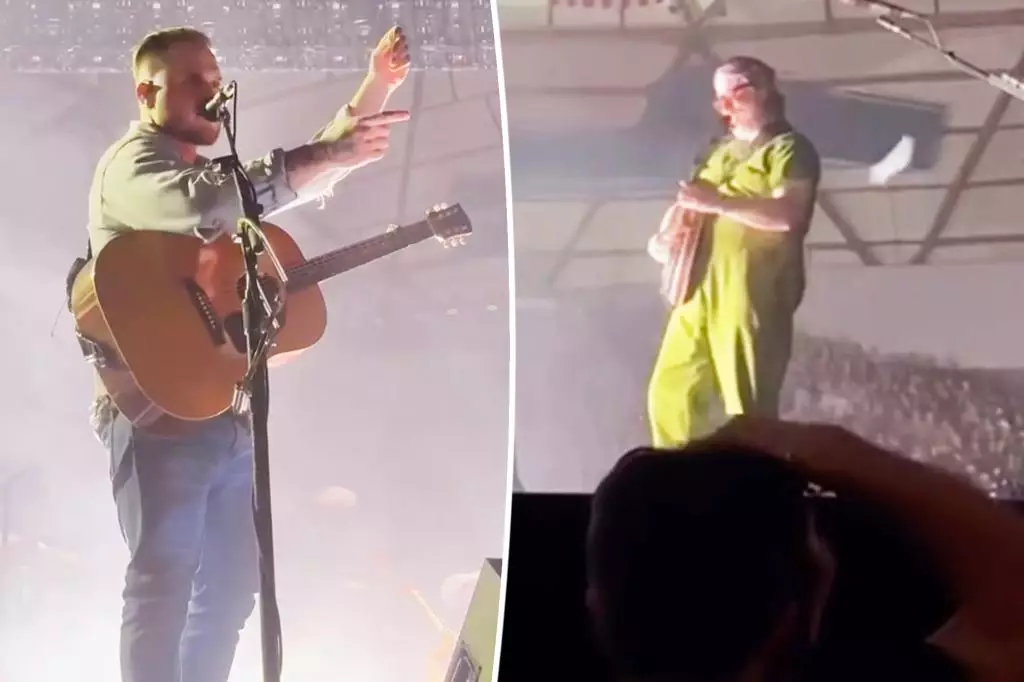The live music scene has long been a sanctuary for both performers and fans, offering a space for emotional expression, community, and the thrill of shared experience. However, recent events point to a troubling trend wherein fans feel emboldened to engage in risky and disruptive behavior during performances. The incident involving country artist Zach Bryan at his recent concert highlights this rising tension. After an object was thrown onto the stage, hitting one of his guitarists, Bryan’s reaction underscored the growing issue of inappropriate fan behavior at concerts.
During a concert at the Tacoma Dome in Washington, Bryan exhibited a palpable sense of frustration as he confronted the audience over the errant projectile. His immediate response—asking, “Who threw this?”—reflected not only his annoyance but also his commitment to maintaining a safe space for artists and crew. The escalation of the situation, with Bryan actively encouraging fans to identify the offender, points to a broader cultural discontent within the concert-going scene.
While fan engagement is often celebrated in the music industry, there are boundaries that should not be crossed. Throwing objects on stage, even with the intention of expressing admiration or excitement, can pose significant risks to the performers. Bryan’s strong admonition—”Don’t throw s–t at concerts!”—is a reminder that what may seem like harmless enthusiasm can quickly devolve into a hazardous situation.
Bryan’s incident is not isolated; it’s part of an alarming trend where artists like Pink, Drake, and Bebe Rexha have faced similar encounters with aggressive fans. From a vape pen hurled at Drake to Bebe Rexha suffering an injury from a phone, the list of incidents continues to grow. Such events provoke questions about the safety protocols at concerts and whether audiences have begun to misconstrue boundaries in expressing their support.
On a personal note, the incident occurred against the backdrop of Bryan’s recent split with influencer Brianna “Chickenfry” LaPaglia. This emotional upheaval adds another layer to the singer’s mental state, possibly influencing his reactions on stage. The public nature of his breakup—coupled with LaPaglia’s allegations of emotional abuse—makes Bryan’s conduct in this incident even more complex. As celebrity lives unfold in the public eye, the pressures can mount, leading to firmly articulated boundaries being set in moments of stress.
Interestingly, the response from fans following such incidents varies, with many either supporting the artist’s protective instincts or questioning the overall culture at concerts. Artistry is often grounded in vulnerability, and when that vulnerability is challenged by aggressive behavior, it can create an overwhelming atmosphere both for artists and their audiences.
As we move deeper into a new era of concert experiences, it’s vital to reassess what it means to engage in live music. Open dialogue between artists and fans about appropriate conduct could foster a more respectful and safe environment for all parties involved. This is essential not just for the success of individual concerts but for the health of the entire live music industry.
Going forward, artists and their teams might consider implementing stricter guidelines regarding audience behavior or enhancing security measures at shows. On the other hand, fans should reflect on their role in creating these experiences. Understanding that an artist’s stage is a space of creativity and vulnerability can encourage audiences to express their support without crossing that critical line.
The incident at Zach Bryan’s concert serves as a wakeup call. It challenges fans to reevaluate their behavior and compels artists to confront their responsibility for safety on stage. Moving ahead, a collaborative approach to maintaining harmony in live music can ensure that concerts remain a celebration of music, connection, and joy rather than a scene marred by chaos.

